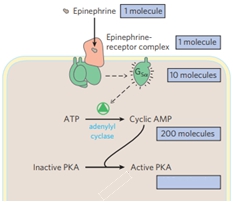So here we're going to briefly revisit our map of the lesson on biosignaling pathways which is down below right here. And, of course, we've been exploring this map by exploring the leftmost branches first, and so we've already introduced G protein-coupled receptors or GPCRs, and we've talked specifically about the stimulatory adenylate cyclase GPCR signal transduction pathway. And so here in this video, we're going to continue to talk more and more about this pathway by talking about the secondary messenger cAMP, and the enzyme protein kinase A or PKA. And so let's go on and get started talking about these.
So now that we've covered stimulatory adenylate cyclase GPCR signaling, here we're going to continue to talk about that same pathway by focusing on the secondary messenger cAMP and the enzyme protein kinase A or PKA for short. And so in this video specifically, we're going to focus on the production and the function of the secondary messenger cAMP. And so recall from our previous lesson videos that the effector enzyme Adenylate Cyclase actually converts its substrate ATP into the secondary messenger cAMP, which is really just an abbreviation for cyclic adenosine monophosphate. So you can see cAMP, comes from that name.
And so if we take a look at our image down below over here on the left-hand side, notice on the left, we're showing you the structure of ATP, which we know again is the substrate for the effector enzyme Adenylate Cyclase. And so notice here as the catalyst to this particular reaction that we're showing, we have the enzyme Adenylate Cyclase in its active form. And so when Adenylate Cyclase is activated, it can actually convert its substrate ATP into the secondary messenger that we see over here, cAMP. And so you can compare the structure of cAMP with ATP to get a good idea that they are related to one another. So notice that P2 inorganic phosphates here are released and, in the process, the phosphate here is cyclic, which is why it's called cyclic adenosine monophosphate because it only has P1 phosphate group that is in a cyclic form as we see down below.
Now really this secondary messenger molecule that we see here, cAMP, again is a secondary messenger that goes on to activate the enzyme that's called cAMP-dependent protein kinase A or just PKA for short. And so you can see PKA comes from this abbreviation for protein kinase A, and this is a cAMP dependent enzyme. And so PKA is only going to become active, in the presence of the cAMP secondary messenger. And so, therefore, what we can say here is that cAMP is going to function as an allosteric activator, which recall that we can symbolize using a positive sign for activation. And so cAMP is an allosteric activator for the enzyme protein kinase A.
And so if we take a look at our right side of the image over here, notice that we're showing you the activation of the enzyme PKA. And notice that we're showing you specifically P4 cAMP molecules. And these P4 cAMP molecules will bind to the inactive form of PKA. And so, when cAMP binds to the inactive form of PKA, as we see above, the cAMP molecules are these little guys that we see when they bind to the inactive form of the PKA, it actually activates the subunits of PKA. And we're going to talk in more detail specifically about this process right here and the activation of PKA in our next lesson video. But for now, what you can see is that cAMP is acting as an allosteric activator for PKA to activate it. And so, this here concludes our introduction to the production and function of cAMP, and I'll see you guys in our next video.


